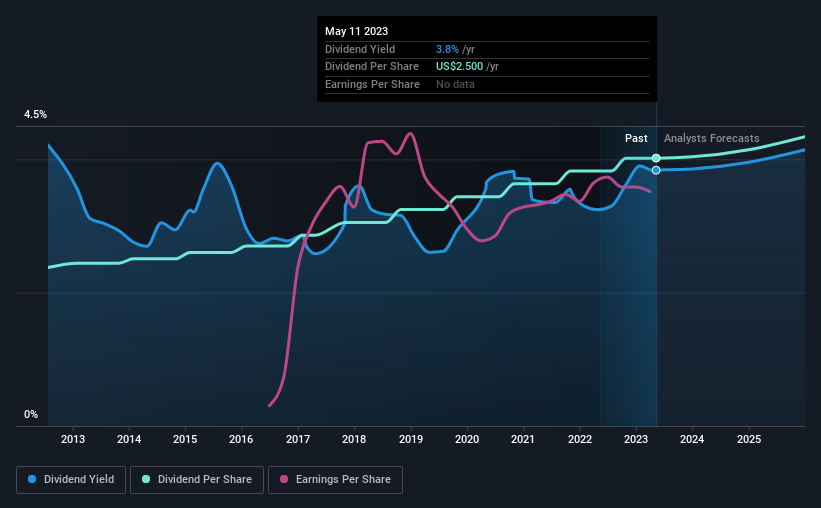Here's Why We're Wary Of Buying Black Hills' (NYSE:BKH) For Its Upcoming Dividend
Black Hills Corporation (NYSE:BKH) is about to trade ex-dividend in the next 4 days. The ex-dividend date is one business day before the record date, which is the cut-off date for shareholders to be present on the company's books to be eligible for a dividend payment. The ex-dividend date is important as the process of settlement involves two full business days. So if you miss that date, you would not show up on the company's books on the record date. This means that investors who purchase Black Hills' shares on or after the 17th of May will not receive the dividend, which will be paid on the 1st of June.
The company's upcoming dividend is US$0.63 a share, following on from the last 12 months, when the company distributed a total of US$2.50 per share to shareholders. Based on the last year's worth of payments, Black Hills stock has a trailing yield of around 3.8% on the current share price of $65.16. Dividends are a major contributor to investment returns for long term holders, but only if the dividend continues to be paid. So we need to investigate whether Black Hills can afford its dividend, and if the dividend could grow.
See our latest analysis for Black Hills
If a company pays out more in dividends than it earned, then the dividend might become unsustainable - hardly an ideal situation. Black Hills paid out more than half (62%) of its earnings last year, which is a regular payout ratio for most companies. Yet cash flow is typically more important than profit for assessing dividend sustainability, so we should always check if the company generated enough cash to afford its dividend. It paid out an unsustainably high 254% of its free cash flow as dividends over the past 12 months, which is worrying. It's pretty hard to pay out more than you earn, so we wonder how Black Hills intends to continue funding this dividend, or if it could be forced to cut the payment.
While Black Hills's dividends were covered by the company's reported profits, cash is somewhat more important, so it's not great to see that the company didn't generate enough cash to pay its dividend. Were this to happen repeatedly, this would be a risk to Black Hills's ability to maintain its dividend.
Click here to see the company's payout ratio, plus analyst estimates of its future dividends.
Have Earnings And Dividends Been Growing?
Companies that aren't growing their earnings can still be valuable, but it is even more important to assess the sustainability of the dividend if it looks like the company will struggle to grow. If earnings fall far enough, the company could be forced to cut its dividend. That explains why we're not overly excited about Black Hills's flat earnings over the past five years. It's better than seeing them drop, certainly, but over the long term, all of the best dividend stocks are able to meaningfully grow their earnings per share. Earnings have been growing somewhat, but we're concerned dividend payments consumed most of the company's cash flow over the past year.
The main way most investors will assess a company's dividend prospects is by checking the historical rate of dividend growth. In the last 10 years, Black Hills has lifted its dividend by approximately 5.4% a year on average.
The Bottom Line
Should investors buy Black Hills for the upcoming dividend? Black Hills is paying out a reasonable percentage of its income yet an uncomfortably high 254% of its cash flow as dividends. What's more, earnings have barely grown. It's not the most attractive proposition from a dividend perspective, and we'd probably give this one a miss for now.
So if you're still interested in Black Hills despite it's poor dividend qualities, you should be well informed on some of the risks facing this stock. We've identified 4 warning signs with Black Hills (at least 1 which is potentially serious), and understanding them should be part of your investment process.
If you're in the market for strong dividend payers, we recommend checking our selection of top dividend stocks.
Have feedback on this article? Concerned about the content? Get in touch with us directly. Alternatively, email editorial-team (at) simplywallst.com.
This article by Simply Wall St is general in nature. We provide commentary based on historical data and analyst forecasts only using an unbiased methodology and our articles are not intended to be financial advice. It does not constitute a recommendation to buy or sell any stock, and does not take account of your objectives, or your financial situation. We aim to bring you long-term focused analysis driven by fundamental data. Note that our analysis may not factor in the latest price-sensitive company announcements or qualitative material. Simply Wall St has no position in any stocks mentioned.
Join A Paid User Research Session
You’ll receive a US$30 Amazon Gift card for 1 hour of your time while helping us build better investing tools for the individual investors like yourself. Sign up here

 Yahoo Finance
Yahoo Finance 
